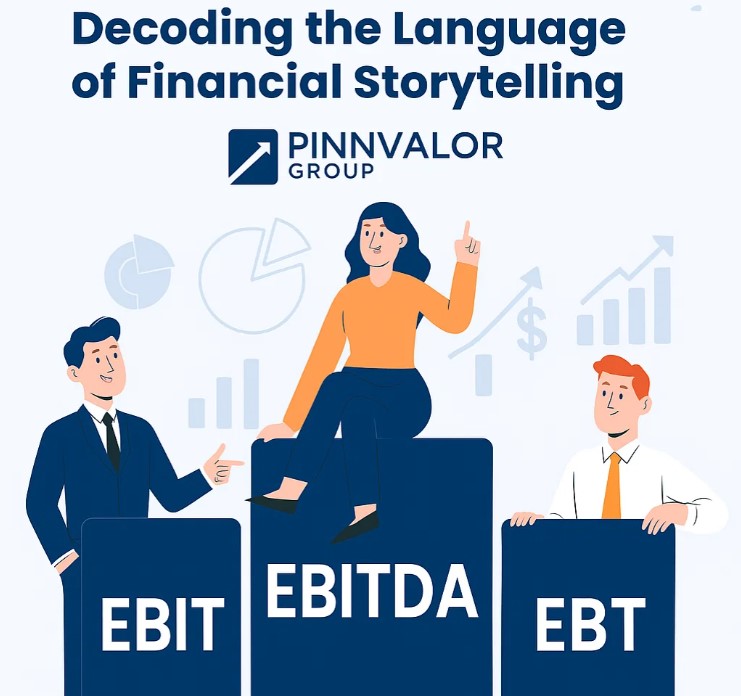
EBIT vs EBITDA vs EBT: Decoding the Language of Financial Storytelling
Financial statements are more than just numbers—they are narratives about a company’s performance, resilience, and future potential. Among the most powerful storytelling tools are profitability metrics like EBIT, EBITDA, and EBT. Each offers a unique perspective on financial health, helping investors, analysts, and decision-makers interpret business results with clarity.
In this blog, we’ll decode these three terms, compare their roles, and explore why understanding the nuances behind them is essential for financial storytelling.
Are your financial metrics telling the full story—or just part of it?
“EBIT shows operational strength, EBITDA reveals cash potential, and EBT uncovers the impact of debt. Together, they complete the financial narrative.
What is EBIT?
EBIT (Earnings Before Interest and Taxes) represents a company’s operating profit. It shows how much profit is generated purely from operations, excluding financing and tax decisions.
- Formula: EBIT = Revenue – Operating Expenses (excluding interest & taxes)
- Purpose: Highlights operational efficiency.
- Use Case: Comparing performance of firms with different financing structures.
Example: If two companies operate in the same industry, EBIT helps reveal which one is more operationally efficient, without being clouded by interest obligations.
What is EBITDA?
EBITDA (Earnings Before Interest, Taxes, Depreciation, and Amortization) adjusts EBIT by excluding non-cash expenses like depreciation and amortization.
- Formula: EBITDA = EBIT + Depreciation + Amortization
- Purpose: Offers a “cash-like” view of earnings.
- Use Case: Widely used in valuation (EV/EBITDA multiples) and when comparing capital-intensive companies.
Example: A telecom company with huge investments in infrastructure might show low EBIT due to depreciation. EBITDA strips this out, reflecting stronger underlying performance.
What is EBT?
EBT (Earnings Before Tax) represents the profit after accounting for interest but before taxes. It demonstrates how financial leverage affects profitability.
- Formula: EBT = EBIT – Interest Expense
- Purpose: Shows the impact of debt and financing on profits.
- Use Case: Useful for comparing firms across tax jurisdictions or for analyzing interest coverage.
Example: Two companies may have similar EBIT, but the one with higher debt (and thus more interest expense) will report lower EBT.
EBIT vs EBITDA vs EBT: Key Differences
| Metric | Includes/Excludes | Focus | Best Used For |
|---|---|---|---|
| EBIT | Includes depreciation & amortization; excludes interest & taxes | Operating performance | Measuring operational efficiency |
| EBITDA | Excludes depreciation & amortization, interest & taxes | Cash-flow like earnings | Valuation and comparing capital-intensive firms |
| EBT | Includes depreciation, amortization & interest; excludes taxes | Impact of financing | Assessing effect of leverage and tax planning |
Why Do These Metrics Matter in Storytelling?
Financial storytelling is not just about showing profit—it’s about showing perspective.
- EBIT tells the story of operations → “How well are we running the business?”
- EBITDA tells the story of cash potential → “How much can we generate to pay debt, invest, or grow?”
- EBT tells the story of financing → “How does debt influence our bottom line before taxes?”
Together, they help stakeholders understand performance from different angles and craft a balanced narrative about financial strength.
Conclusion
EBIT, EBITDA, and EBT are not just accounting jargon—they are chapters in the financial story of any business. A skilled analyst or leader knows when to use each measure to highlight operational excellence, cash-generation capacity, or the impact of financing.
In the world of financial storytelling, the real power lies not in the numbers themselves, but in the ability to interpret and communicate them with clarity.

